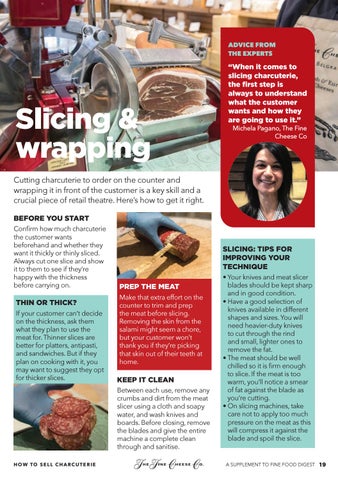ADVICE FROM THE EXPERTS
Slicing & wrapping
“When it comes to slicing charcuterie, the first step is always to understand what the customer wants and how they are going to use it.”
Michela Pagano, The Fine Cheese Co
Cutting charcuterie to order on the counter and wrapping it in front of the customer is a key skill and a crucial piece of retail theatre. Here’s how to get it right. BEFORE YOU START
Confirm how much charcuterie the customer wants beforehand and whether they want it thickly or thinly sliced. Always cut one slice and show it to them to see if they’re happy with the thickness before carrying on.
THIN OR THICK?
If your customer can’t decide on the thickness, ask them what they plan to use the meat for. Thinner slices are better for platters, antipasti, and sandwiches. But if they plan on cooking with it, you may want to suggest they opt for thicker slices.
SLICING: TIPS FOR IMPROVING YOUR TECHNIQUE PREP THE MEAT
Make that extra effort on the counter to trim and prep the meat before slicing. Removing the skin from the salami might seem a chore, but your customer won’t thank you if they’re picking that skin out of their teeth at home.
KEEP IT CLEAN
Between each use, remove any crumbs and dirt from the meat slicer using a cloth and soapy water, and wash knives and boards. Before closing, remove the blades and give the entire machine a complete clean through and sanitise. H O W TO S E L L C H A R C U T E R I E
• Your knives and meat slicer blades should be kept sharp and in good condition. • Have a good selection of knives available in different shapes and sizes. You will need heavier-duty knives to cut through the rind and small, lighter ones to remove the fat. • The meat should be well chilled so it is firm enough to slice. If the meat is too warm, you’ll notice a smear of fat against the blade as you’re cutting. • On slicing machines, take care not to apply too much pressure on the meat as this will compress it against the blade and spoil the slice. A SUPPLEMENT TO FINE FOOD DIGEST 19








